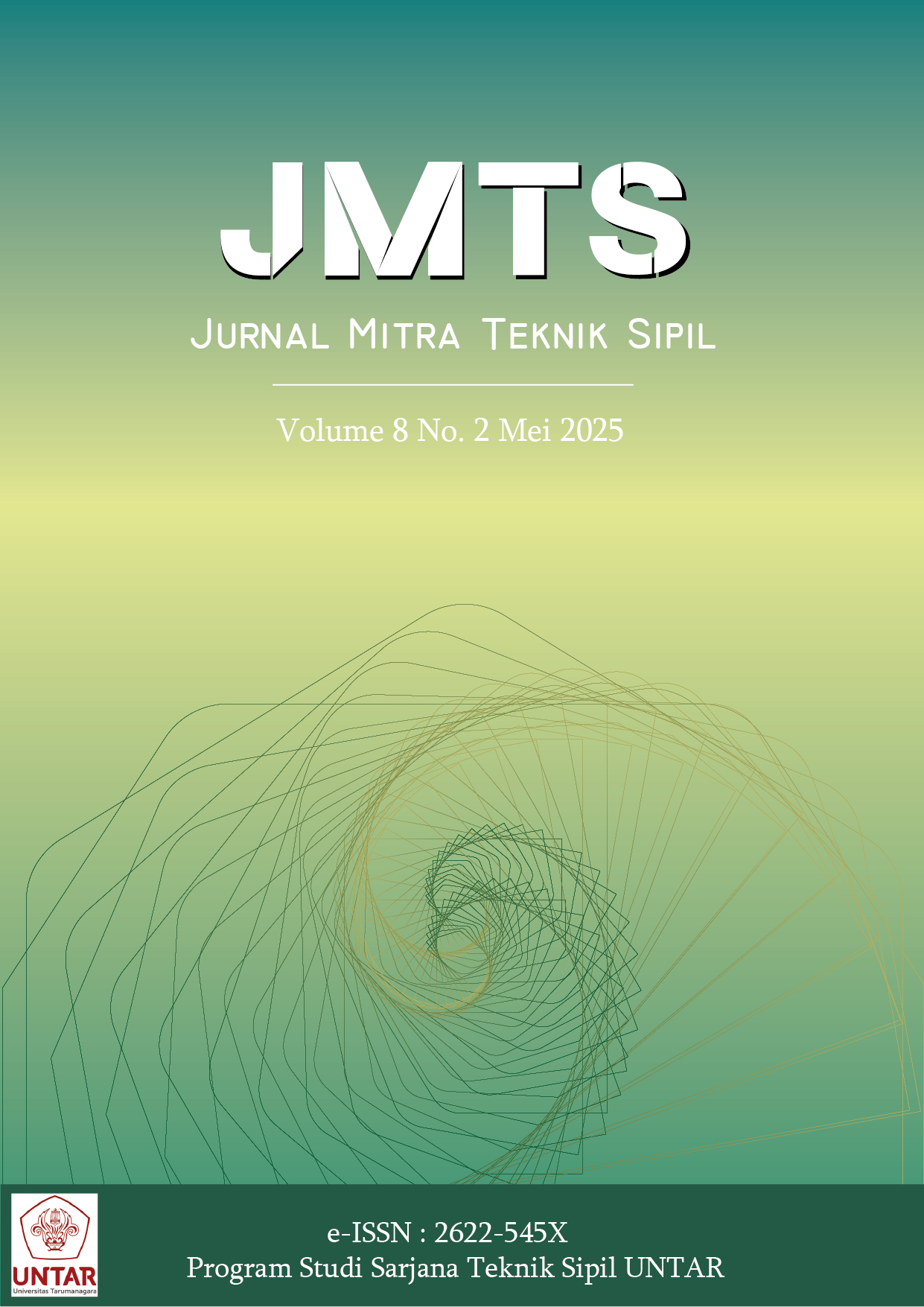PENGARUH DEBU PADA LUBANG ANGKUR TERHADAP KUAT TARIK ANGKUR ADHESIF
Main Article Content
Abstract
An anchor is a steel material that functions as a connector between materials. Based on the installation method, anchors can be classified into two types: cast-in-place anchors and post-installed anchors. One advantage of post-installed anchors is the faster curing time. Adhesive anchors are a type of post-installed anchor used in this study. Several factors can affect the strength of adhesive anchors, one of which is the cleanliness of the drilled hole. This research was conducted by making concrete samples, then drilling them and installing anchors into the holes. A total of 4 samples were tested, consisting of 2 samples in cleaned conditions and 2 samples in uncleaned conditions. The anchor samples used are threaded reinforcement bars with diameters of 13 mm and 16 mm. The testing was performed using a tensile test with the confined test method. The results of the testing concluded that the cleanliness of the drilled hole significantly affects the tensile capacity of the anchor. The average tensile capacity of the 13 mm diameter anchor in the cleaned condition is 44.1 kN and 7.64 kN in the uncleaned condition. For the 16 mm diameter anchor, the average tensile capacity is 64.68 kN in the cleaned condition and 22.87 kN in the uncleaned condition.
Abstrak
Angkur merupakan material baja yang berfungsi sebagai penyambung antara material. Berdasarkan cara pemasangannya, angkur dapat dibedakan menjadi dua jenis, yaitu angkur cor di tempat dan angkur pasca pasang. Salah satu kelebihan angkur pasca pasang adalah waktu curing yang lebih cepat. Angkur adhesif merupakan salah satu jenis angkur pasca pasang yang digunakan dalam penelitian ini. Terdapat beberapa faktor yang dapat mempengaruhi kekuatan angkur adhesif, salah satunya adalah kebersihan dari lubang bor. Penelitian ini dilakukan dengan membuat sampel beton lalu mengebornya kemudian melakukan instalasi angkur ke dalam lubang tersebut. Sampel yang diuji sebanyak 4 buah, yang terdiri atas 2 sampel kondisi cleaned dan 2 sampel kondisi uncleaned. Sampel angkur yang digunakan adalah tulangan ulir dengan ukuran diameter 13 mm dan 16 mm. Pengujian dilakukan dengan uji tarik dengan metode confined test. Dari hasil pengujian dapat disimpulkan bahwa kondisi lubang bor yang dibersihkan dan yang tidak dibersihkan memiliki pengaruh yang signifikan terhadap kapasitas tarik angkur dengan perolehan rata-rata kapasitas tarik angkur diameter 13 mm kondisi cleaned sebesar 44,1 kN dan kondisi uncleaned sebesar 7,64 kN dan rata-rata kapasitas tarik angkur diameter 16 mm kondisi cleaned sebesar 64,68 kN dan kondisi uncleaned sebesar 22,87 kN.
Article Details

This work is licensed under a Creative Commons Attribution-NonCommercial-ShareAlike 4.0 International License.
This work is licensed under Jurnal Mitra Teknik Sipil (JMTS) Creative Commons Attribution-ShareAlike 4.0 International License.References
Badan Standardisasi Nasional. (2019). Persyaratan beton struktural untuk bangunan gedung dan penjelasan (SNI 2847:2019). http://sispk.bsn.go.id/SNI/DaftarList
Droesch, D. (2015). Bonded Anchors in Concrete Under Sustained Loading.
González, F., Fernández, J., Agranati, G., & Villanueva, P. (2018). Influence of construction conditions on strength of post installed bonded anchors. Construction and Building Materials, 165, 272-283.
Haidar, H. H., Mussa, F. I., Dawood, A. O., Ghazi, A. A., & Gabbar, R. A. (2020). Experimental study of post installed rebar anchor systems for concrete structure. Civil and Environmental Engineering, 16(2), 308–319. https://doi.org/10.2478/cee-2020-0031
Lundin, R. (2012). Introduction to concrete anchor rods. Kansas State University. https://krex.k-state.edu/server/api/core/bitstreams/a7998c7d-9b5d-49e8-b3df-497e024d959d/content
Tarawneh, A. N. (2019). Behavior and design of post-installed anchors in thin concrete members [Doctoral dissertation, Clemson University]. https://core.ac.uk/download/pdf/268683974.pdf
Tayeh, B. A., EL dada, Z. M., Shihada, S., & Yusuf, M. O. (2019). Pull-out behavior of post installed rebar connections using chemical adhesives and cement based binders. Journal of King Saud University - Engineering Sciences, 31(4), 332–339. https://doi.org/10.1016/j.jksues.2017.11.005



